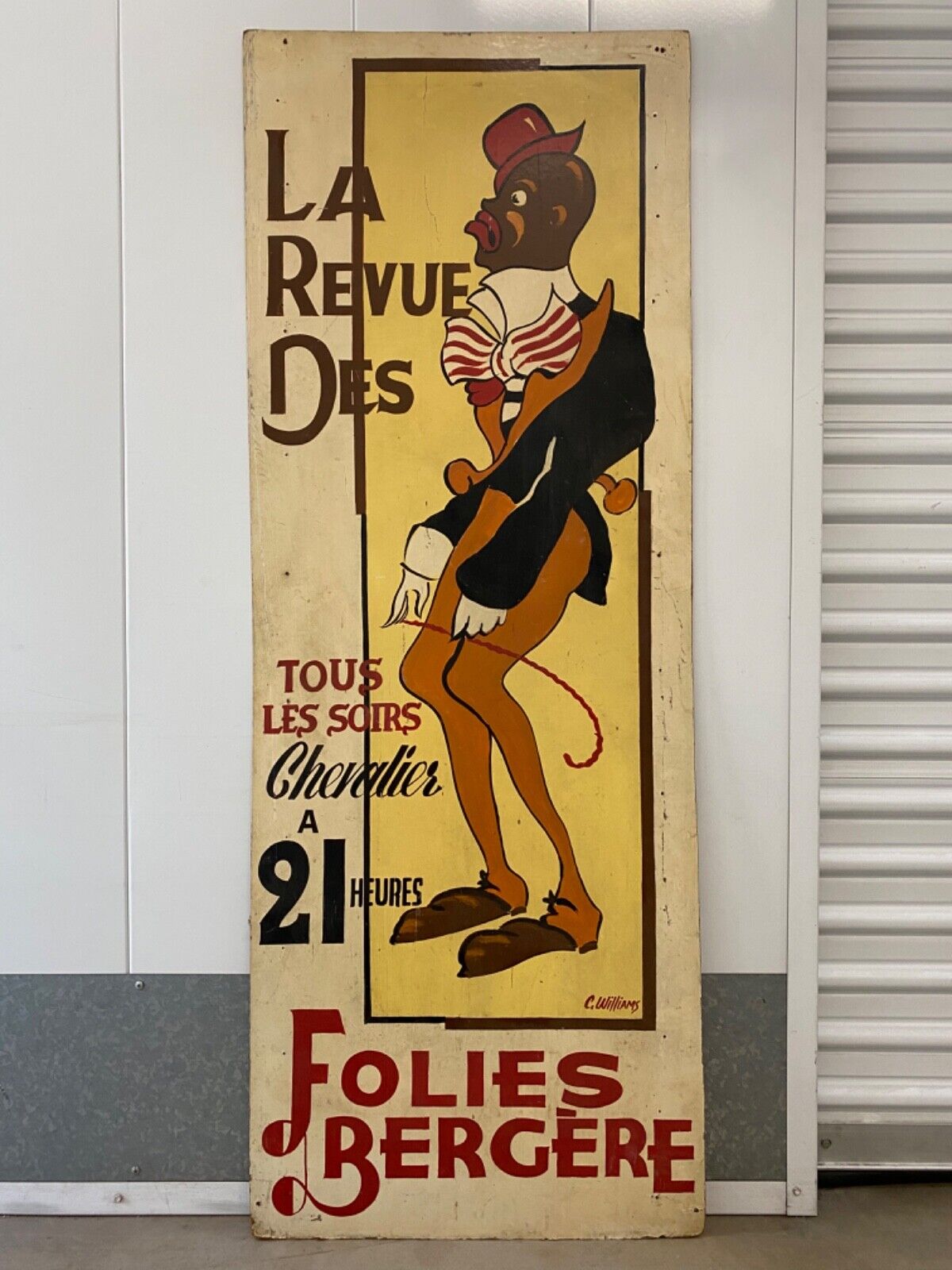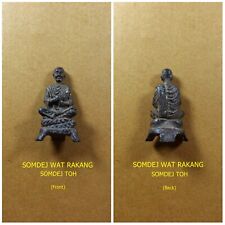🔥 RARE Important French Folies Bergere Paris Cabaret Sign Painting, 1930s - WOW

When you click on links to various merchants on this site and make a purchase, this can result in this site earning a commission. Affiliate programs and affiliations include, but are not limited to, the eBay Partner Network.
🔥 RARE Important French Folies Bergere Paris Cabaret Sign Painting, 1930s - WOW:
$9500.00
This is an incredible andRARE Important French Folies Bergere Paris Cabaret Sign Painting, Oil on Masonite, depicting an advertisement for the famous Parisian cabaret house, Folies Bergere. This artwork depicts a dapper and haughty Black gentleman and reads: "La Revue des Folies Bergere...Tous Les Soirs Chavalier a 21 Heures." Signed: "C. Williams" at the lower right edge. I could not find any information on this artist, but perhaps you know more about him or his work? I also cannot find this particular image ANYWHERE online, and I believe that it is a one-off and unique hand painted sign that was tacked to the front of Folies Bergere or a nearby Parisian building (If I am wrong, I welcome you to correct me with information about the image.) This artwork likely dates to the 1930's - 1940's. The story that came with this piece is that it was brought back by an American soldier during WWII. I don't have any more additional details to confirm this, but due to the wafer-thin, early variant of Masonite that this is painted on, signs of genuine patina and honest age, and the fact that American troops were present during and after the Liberation of Paris of 1944, it is absolutely plausible, and I believe it to be true. It is even possible that this advertisement sign was painted by an American G.I. with a backgroundin art, due to the Anglicizedlast name of the artist and the New Deal Program of the 1930's that many former soldierswere a part of. Approximately22 3/4 x 61 inches. This large sign would have captured the attention of any passerby from far away, which was its intention. Good condition for age and outdoor display use, with expected, scuffing, scratches, edge wear, minor paint loss and pin holes from being nailed to a building (please see photos.) This is without a doubt the only one you will ever see in your lifetime. It is far rarer than printed posters for Folies Bergere from this era, or earlier. This is for the serious and discerning collector. Acquired in Pasadena, California. If you like what you see, I encourage you to make an Offer. Please check out my other listings for more wonderful and unique artworks!
About Folies Bergere:
Folies Bergère
Established in 1869, the Folies Bergere is a cabaret music hall still in use today in Paris, France. It came to fame and popularity from the 1890's Belle Epoque period to the 1920's Annees Folles. Serving as a symbol of Parisian life, the hall has is steeped in history and has many legends associated with it. Josephine Baker started her successful career there in 1926. The space itself is described as spacious and grand. Spectators could come and go freely between acts. The Folies Bergere was the inspiration for one of the most famous impressionist painting, "The Bar at the Folies-Bergere" by Manet in 1882.
The Folies Bergère is a mythical place, one of the most renowned cabarets in the world. One of Paris’s original music halls, the very firstrevueswere performed in the late 1880s. Ever since, Les Folies Bergère has hosted performances by true legends, including Charlie Chaplin, Josephine Baker, Charles Trénet, and French writer Colette, to name but a few. It also inspired a lot of artists, writers, and countless film directors.
To many Parisians, the name Folies Bergère inevitably evokes the Belle Epoque, images of dancers sketched by Toulouse-Lautrec, the exuberant and saucy acts of Josephine Baker, orencore, the sad looking bartender of Manet’s “Le Bar des Folies Bergère.”
Once a hall for operettas, pantomime, political meetings and vaudeville, the Folies Bergère in Parisintroduces an elaborate revue featuring women in sensational costumes on November 30, 1886. The highly popular “Place aux Jeunes” established the Folies as the premier nightlife spot in Paris. In the 1890s, the Folies followed the Parisian taste for striptease and quickly gained a reputation for its spectacular nude shows. The theater spared no expense, staging revues that featured as many as 40 sets, 1,000 costumes, and an off-stage crew of some 200 people.
The Folies Bergère dates back to 1869, when it opened as one of the first major music halls in Paris. It produced light opera and pantomimes with unknown singers and proved a resounding failure. Greater success came in the 1870s, when the Folies Bergère staged vaudeville. Among other performers, the early vaudeville shows featured acrobats, a snake charmer, a boxing kangaroo, trained elephants, the world’s tallest man, and a Greek prince who was covered in tattoos allegedly as punishment for trying to seduce the Shah of Persia’s daughter. The public was allowed to drink and socialize in the theater’s indoor garden and promenade area, and the Folies Bergère became synonymous with the carnal temptations of the French capital. Famous paintings by Édouard Manet and Henri de Toulouse-Lautrec were set in the Folies.
In 1886, the Folies Bergère went under new management, which, on November 30, staged the first revue-style music hall show. The “Place aux Jeunes,” featuring scantily clad chorus girls, was a tremendous success. The Folies women gradually wore less and less as the 20th century approached, and the show’s costumes and sets became more and more outrageous. Among the performers who got their start at the Folies Bergère were Yvette Guilbert, Maurice Chevalier, and Mistinguett. The African American dancer and singer Josephine Baker made her Folies debut in 1926, lowered from the ceiling in a flower-covered sphere that opened onstage to reveal her wearing a G-string ornamented with bananas.
The Folies Bergère remained a success throughout the 20th century and still can be seen in Paris today, although the theater now features many mainstream concerts and performances. Among other traditions that date back more than a century, the show’s title always contains 13 letters and includes the word “Folie.”
It was the architect Plumeret, who was a building inspector of the crown, that designed the building based on the Alhambra music hall in London, and it was originally meant to be a lavish, elegant opera house.
Inaugurated 2nd May 1869First inaugurated on 2nd May 1869 with all the grandeur that was expected of such a venue, it had been the customary to name theatres,also known as folies, after where they were located in the city, and therefore the original name was Folies Trevise because of a street of that name by the stage door. However, the Duc de Trevise objected, as he did not want his name associated with a theatre.
The next name was going to be Folies Richer, but again this was also a surname, and therefore they decided on the name Folies Bergerewhich was a street name nearby, plus this did not refer to any nobility or upset any people as there was no family name associated with this.
However, the success of the Folies Bergere was not at the time what was to be expected, and it ended up being a place for political discussions during the Paris Commune, but was then purchased by Leon Sari and re-opened in 1872.
Yet even then it was not plain sailing and Sari was on the verge of bankruptcy and sold this music hall venue in Paris,but when it re-opened yet again, there were numerous types of different acts from singers, operettas and comedy through to circus style acts with elephants, snake charmers and acrobats.
It was in 1886 that the first group of European girls appears on stage and by the 1890s, with striptease becoming more and more popular, the girls were getting to wear less and less, until eventually when the Folies Bergere became known for its spectacular shows with entirely naked girls.
Over the years this cabaret venue in Parisbecame even more popular, especially just prior to World War I and then after the war when Paul Derval took over, which lasted through the roaring 20s.
He was very superstitious and always made sure that a revue, or show, had 13 letters, the same as its name and continued with the naked girls, yet he also incorporated numerous different stage acts, fancy costumes and fabulous sets, which led to even greater success.
Plus Paul Derval also had numerous well known names in show business that starred at the Folies Bergere such as Charlie Chaplin, Maurice Chevalier, Mistinguett and Jospehine Baker who caused a scandal when she appeared scantily dressed with a banana skirt, literally made with banana skins!
Initially, because he had a Jewish gentleman helping organise and produce the revues and the Germans occupying Paris during World War II, the Folies Bergere was closed, which the Germans were not at all happy about. But eventually, it re-opened through lots of negotiations with Paul Derval, even though the Jew Michel Gyarmathy was always hidden.
And throughout this and after the Liberation of ParisDerval ran the Folies Bergere, and did so for nearly half a century, yet his successors continued with the tradition, providing even more elaborate reviews that ensured the continued worldwide appeal of this theatre style entertainment venue in Paris.
Helene Martini took over in 1974, and in 1980 the Folies Bergere celebrated its 50 millionth visitor, which at the time was equivalent to the whole population of France, but she continued its appeal and fame, so that the Folies Bergere could become even more of a legend.
Yet by the 1990s, although the elaborate reviews were still in place that had always been really for male pleasure, times were changing and other types of shows were now being organised and performed at this cabaret in Paris.
So, then came shows such as Fame, along with the California Dream Men for ladies pleasure, along with many other musicals and different types of shows suitable for all ages, even though they still hold their famous review with the same elements that made the Folies Bergere famous.
And of course, the Folies Bergere is still one of the major tourist attractions in Paristhat you can enjoy today with its elegant and sophisticated decor along with spectacular shows and the famous elaborate revues.
A Brief History of the Folies-Bergère
"The Folies-Bergères [sic] , rue Richter 32, near the Boulevard Montmartre, a very popular resort... visitors take seats where thy please, or promenade in the galleries, while musical, dramatic and conjuring performances are given on the stage. Admission 2Fr"
Baedeker,Paris and Its Environs, 1878
Quoted by T. J. Clark
The Folies-Bergère was the first music-hall to be opened in Paris. It was conceived in conscious imitation of the Alhambra in London, a music hall known and much-loved for broad comedy, opera, ballet and circus.
The Folies-Bergère was supposed to be the Folies Trevise, because it was on the corner of the rue Richter and the rue Trevise. The Duc de Trevise would not allow his name to be brought into such potential ill-repute. The rue Bergère, a road named after a master dyer, was a block or so away. 'Folies' came from the Latin, foliae, meaning 'leaves' but transmogrified into 'field' and thence to a place for open-air entertainment.
The Folies-Bergère opened in May 1869, not far from the heart of the post-Haussmann cultural centre of Paris, south of Montmartre, a little east of the boulevard des Italiens (known simply as The Boulevard). Entry cost 2 francs for an unreserved seat.
In November 1871, following the considerable interruptions of the Franco-Prussian War and the Paris Commune, the theatre was taken over by Leon Sari, who remodelled the auditorium, put in the famous promenade, and installed a 'garden' with a large central fountain.
A Folies-Bergère show typically included ballet, acrobatics, pantomime, operetta, animal acts, many including spectacular special effects. However, the Folies-Bergère was perhaps more well-known for its sensual allures, as described by Huysmans and Maupassant.
The women of thepromenoirwere required to demonstrate discretion; none were allowed in without fortnightly-renewable cards issued by the management. This arrangement lasted until 1918.
Artists and writers were drawn to the Folies-Bergère and establishments like it not least because they were fascinating venues for the practice of social anthropology, where different classes met in an Environment in which strict bourgeois morality held no sway whatsoever. Manet's picture features his friends - artists and models; it is the kind of fashionable place in which he spent his evenings.
WPW
ref: Charles Castle,The Folies-Bergère, Methuen 1982
🔥 RARE Important French Folies Bergere Paris Cabaret Sign Painting, 1930s - WOW:
$9500.00

Related Items:
RARE TRICERATOPS (DINOSAUR) BLACK EGG FOSSIL- QUINAULT INDIAN NATION, WA. STATE
$5995900.99
Antique Rare TOP AMULET of THAILAND (of ASIA) Buddha Statue Pendant ,200Yrs.#12
$5800000.00
Antique Rare TOP AMULET of THAILAND (of ASIA) Buddha Statue Pendant ,200Yrs.#10
$5500000.00







